Automated Passenger Counting and Information System Market by Offering (APC System, PIS), Technology (IR, Stereoscopic, ToF, Structured Light), Type (Display, Infotainment, Announcements & Emergency Communication) Application - Global Forecast to 2029
[210 Pages Report] The global automated passenger counting and information system market was valued at USD 9.2 billion in 2024 and is estimated to reach USD 15.4 billion by 2029, registering a CAGR of 10.7% during the forecast period. The automated passenger counting and information system market is being propelled by the growing need for efficient public transportation management, demand for real-time passenger data analytics, and advancements in sensor technology enabling accurate counting and tracking functionalities. Additionally, government initiatives to modernize transportation infrastructure and enhance passenger experience further drive market growth.
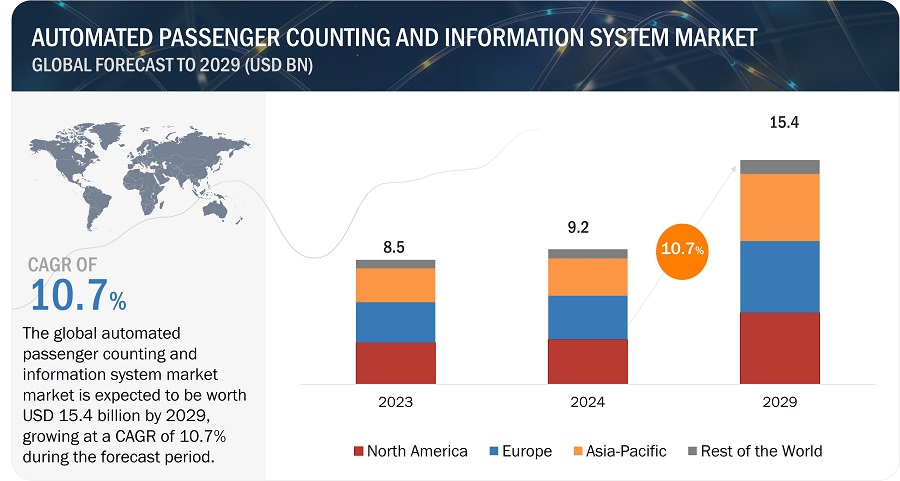
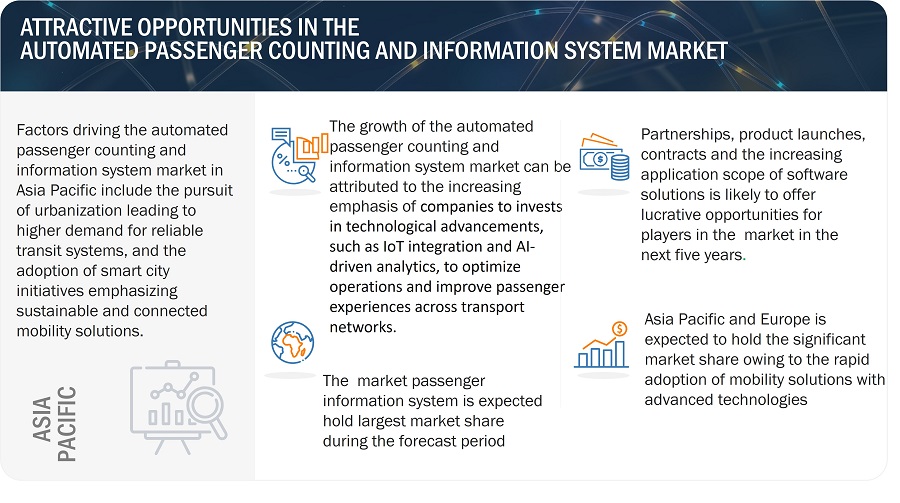
Automated Passenger Counting and Information System Market Forecast to 2029
To know about the assumptions considered for the study, Request for Free Sample Report
Market Dynamics:
Driver: Rising government regulations in various countries regarding the requirement of transportation data
A significant driver behind the expansion of the automated passenger counting system market is the imposition of government regulations in certain nations mandating fleet operators to regularly submit ridership data to government entities. These authorities utilize such information to monitor public transport demands, formulate regional development strategies, and analyze commuting patterns. The escalating global population underscores the increasing necessity for effectively managing public transportation services. Consequently, numerous governments are initiating efforts to compile comprehensive databases encompassing passenger trips across all public transport modes, including buses, trains, and ferries. Transit agencies are adopting advanced passenger information systems comprising display units, infotainment platforms, mobile apps, and announcement systems. Among these, the prevalence of mobile apps and infotainment platforms is anticipated to surge, thereby fueling market expansion. For instance, NEC's Public Safety solutions, like the Transit Management System (TMS) and Passenger Information Systems (PIS), equip transit agencies and operators with data-driven tools for fleet planning, performance evaluation, and vehicle monitoring, ultimately enhancing operational efficiency and commuter experiences.
Restraint: Existence of conventional infrastructures incompatible with advanced passenger information systems
The presence of conventional infrastructures presents a formidable obstacle to implementing advanced passenger information systems, primarily due to limited compatibility, high upgrade costs, technical complexities, data integration challenges, maintenance burdens, and user adoption hurdles. Outdated technologies often lack the necessary components and connectivity to support modern systems, requiring costly upgrades and intricate integration processes. Moreover, the fragmentation of data sources and formats complicates real-time information aggregation and dissemination while maintaining legacy infrastructure alongside new systems strains resources and prolongs downtime. Additionally, users accustomed to traditional information channels may resist transitioning to unfamiliar interfaces, impeding widespread adoption. Overcoming these challenges demands comprehensive planning, investment, and technological innovation to ensure the seamless integration and functionality of advanced passenger information systems within existing transportation infrastructures.
Opportunity: Increasing technological development in automated passenger counting systems
Significant technological advancements in automated passenger counting systems include the integration of advanced sensors such as LiDAR and stereo cameras for more accurate and reliable counting, the development of sophisticated data analytics algorithms leveraging machine learning and artificial intelligence to process large volumes of data in real-time, the implementation of cloud-based storage and computing solutions for scalable and flexible data management, and the integration of IoT (Internet of Things) connectivity for seamless communication between onboard sensors and central control systems. These advancements enhance the precision, efficiency, and scalability of automated passenger counting systems, enabling transit authorities to obtain valuable insights into passenger behavior, optimize service planning and resource allocation, and improve overall operational efficiency and passenger experience. For instance, EXEROS Technologies Ltd provides an APC system utilizing advanced 3D sensor technology to track passenger boarding and alighting precisely. This system, available standalone or integrated into their AI vehicle CCTV platform, offers easy installation and accurate data recording. It empowers public transport operators to optimize vehicle scheduling based on passenger load.
Challenge: Lack of proper network connectivity for APC system
Insufficient network connectivity poses a significant challenge in the automated passenger counting and information systems market. In areas with inadequate network infrastructure or unstable internet connectivity, real-time data transmission between onboard sensors and central monitoring systems becomes unreliable, leading to delays or gaps in passenger counting and information dissemination. This limitation inhibits the systems' ability to provide accurate and up-to-date information to transit authorities and passengers, impacting operational efficiency and passenger satisfaction. Additionally, the reliance on network connectivity for system updates and maintenance exacerbates the challenge, as maintenance tasks may be delayed or compromised in areas with poor connectivity, increasing the risk of system downtime and service disruptions. Overall, addressing the issue of network connectivity is crucial for maximizing the effectiveness and reliability of automated passenger counting and information systems in the market.
Automated Passenger Counting System Market Ecosystem
The Automated passenger counting system market is competitive, with major companies such as Eurotech (Italy), Iris-GmbH (Germany), DILAX Intelcom GmbH (Germany), HELLA Agalia Mobile Vision(Germany) and Infodev EDI (US), among others are the significant providers of automated passenger counting system and numerous small- and medium-sized vital enterprises. Many players offer automated passenger counting and information system solutions, while many players and details offer integration services. These integration services are widely required in various applications for the transportation industry.
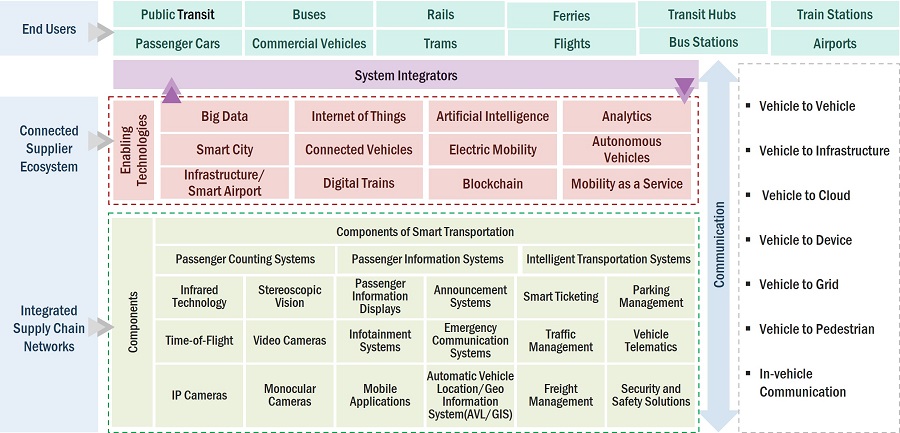
Based on the technology, the stereoscopic vision segment is expected to account for the largest market share during the forecast period.
Stereoscopic vision technology is poised to contribute to the automated passenger counting system market substantially. This technology, leveraging depth perception from multiple cameras, enhances accuracy in identifying and tracking passengers, particularly in crowded or dynamic environments such as public transit. By capturing 3D images and analyzing spatial data, stereoscopic vision systems offer improved reliability in passenger counting compared to traditional 2D methods. This heightened accuracy translates into more precise ridership data, enabling transit authorities to optimize resource allocation, enhance service planning, and improve overall operational efficiency. As the demand for reliable and efficient passenger counting solutions grows, stereoscopic vision technology is expected to drive market expansion and innovation.
Based on the application, the segment for buses is projected to contribute significantly to the market share during the forecast period
Buses are anticipated to contribute significantly to the market share of the automated passenger counting system market for several reasons. Buses are one of the most widely used modes of public transportation in urban and suburban areas. As a result, there is a substantial demand for accurate and efficient passenger counting solutions to optimize bus operations, improve service quality, and enhance passenger satisfaction. Furthermore, buses typically operate on fixed routes with designated stops, making them conducive environments for implementing automated passenger counting systems. This allows for easier installation and integration of counting sensors and other hardware components.
Additionally, the relatively controlled environment within buses compared to other modes of transportation, such as trains or trams, simplifies data collection and analysis, leading to more accurate and reliable passenger counts. Furthermore, the modular nature of bus-based counting systems allows for scalability and customization to meet the specific needs of transit agencies and operators, further driving their adoption and market penetration. Overall, the widespread use of buses, combined with their suitability for deploying automated passenger counting solutions, positions applications in buses as significant contributors to the growth of the market.
Based on region, Asia Pacific is projected to grow fastest for the passenger information system market
The automated passenger counting and information system market in Asia Pacific includes China, Japan, South Korea, and the rest of Asia Pacific. Projected to exhibit the highest Compound Annual Growth Rate (CAGR) between 2024 and 2029, the Asia Pacific region's automated passenger counting and information system market is poised for significant expansion. This growth is fueled by the escalating adoption of passenger counting and information systems within transit vehicles to deliver dependable, secure, and punctual transportation services. Countries like China and India, boasting vast population bases, alongside the ongoing population growth in nations like Australia, drive the demand for intelligent transportation networks, ensuring passengers a reliable and secure travel experience. The burgeoning transportation sector, sustained investments to enhance public transit services, and the increasing integration of smart solutions within the transportation domain across the Asia Pacific present lucrative growth prospects for the market.
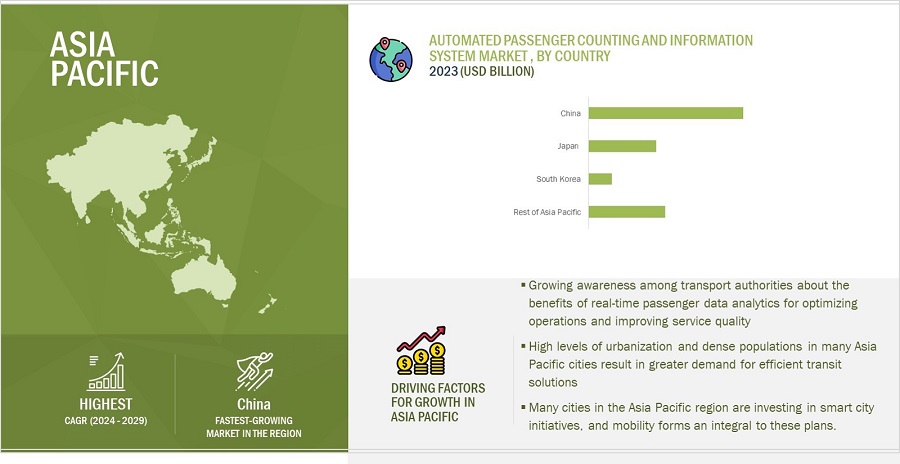
Automated Passenger Counting and Information System Market by Region
To know about the assumptions considered for the study, download the pdf brochure
Key Market Players
The automated passenger counting and information system companies is dominated by a few globally established players such as Eurotech (Italy), Iris-GmbH (Germany), DILAX Intelcom GmbH (Germany), HELLA Agalia Mobile Vision(Germany) and Infodev EDI (US). Etc.
Get online access to the report on the World's First Market Intelligence Cloud
- Easy to Download Historical Data & Forecast Numbers
- Company Analysis Dashboard for high growth potential opportunities
- Research Analyst Access for customization & queries
- Competitor Analysis with Interactive dashboard
- Latest News, Updates & Trend analysis
Request Sample Scope of the Report
Get online access to the report on the World's First Market Intelligence Cloud
- Easy to Download Historical Data & Forecast Numbers
- Company Analysis Dashboard for high growth potential opportunities
- Research Analyst Access for customization & queries
- Competitor Analysis with Interactive dashboard
- Latest News, Updates & Trend analysis
|
Report Metric |
Details |
|
Market Size Availability for Years |
2020–2029 |
|
Base Year |
2023 |
|
Forecast Period |
2024–2029 |
|
Forecast Units |
Value (USD) |
|
Segments Covered |
Offering, APC-Technology, Application, PIS -System Type and Region. |
|
Geographies Covered |
North America, Europe, Asia Pacific, and Rest of the world |
|
Companies Covered |
Eurotech (Italy), Iris-GmbH (Germany), DILAX Intelcom GmbH (Germany), HELLA Agalia Mobile Vision(Germany) and Infodev EDI (US), Siemens (Germany), Hitach Ltd (Japan)among others |
Automated Passenger Counting and Information System Market Highlights
This research report categorizes the automated passenger counting and information system market based on offering & application, and region
|
Segment |
Subsegment |
|
Based on Offering: |
|
|
APC System market, by Technology |
|
|
APC System market, by Applications |
|
|
PIS market, by Type |
|
|
PIS market, by Applications |
|
|
Based on Region: |
|
Recent Developments
- In November 2023, At APTA EXPO 2023, iris-GMBH unveiled the IRMA 6 R2 sensor generation and introduced the HYDRA IP video surveillance system. IRMA sensors employ advanced image processing and AI algorithms for real-time passenger and object counting, utilized by over 150 transit agencies across North America.
- In June 2023, The X-Wagen metro by Siemens started passenger service on the Viennese metro lines. The new rolling stock featured an innovative digital passenger information and guidance system, displaying real-time information above each door.
- In September 2022, Eurotech introduced its latest Edge AI solutions tailored for public transportation. These solutions are certified for use in both Road and Rail vehicles, paving the way for advanced mobility applications in the next era of transportation.
Frequently Asked Questions (FAQs):
Which are the major companies in the automated passenger counting system market? What are their significant strategies to strengthen their market presence?
The major companies in the automated passenger counting market are – Eurotech (Italy), Iris-GmbH (Germany), DILAX Intelcom GmbH (Germany), HELLA Agalia Mobile Vision(Germany) and Infodev EDI (US), among others,, and so on. The significant strategies these players adopt are product launches and developments, contracts, collaborations, acquisitions, and expansions.
What is the region's potential automated passenger counting and information systems market?
The Asia Pacific region is expected to grow fastest in the automated passenger counting and information system market.
What are the opportunities for new market entrants?
Opportunities in the automated passenger counting and information system market arise from the growth of the automotive sectors due to the growing mobility trend and integration of transportation with advanced technologies.
What are the drivers and opportunities for the automated passenger counting and information system market?
Factors such as the increasing demand for efficient public transportation management and the growing emphasis on real-time data analytics, advancements in sensor technology, and government initiatives worldwide to modernize transportation infrastructure and improve passenger experience are fostering the need to grow the automated passenger counting and information system market.
Who are the major end users of the industry expected to drive the market's growth in the next five years?
The significant consumers for automated passenger counting and information systems are buses, trains, trams, ferries, and other means of passenger vehicles.
To speak to our analyst for a discussion on the above findings, click Speak to Analyst
The study utilized four major activities to estimate the automated passenger counting and information system market size. Exhaustive secondary research was conducted to gather information on the market and its peer and parent markets. The next step was to validate these findings, assumptions, and sizing with industry experts across the value chain through primary research. Both top-down and bottom-up approaches were employed to estimate the total market size. Finally, market breakdown and data triangulation methods were utilized to estimate the market size for different segments and subsegments.
Secondary Research
In the secondary research process, various sources were used to identify and collect information on the automated passenger counting and information system market for this study. Secondary sources for this research study include corporate filings (such as annual reports, investor presentations, and financial statements), trade, business, and professional associations, white papers, certified publications, articles by recognized authors, directories, and databases. The secondary data was collected and analyzed to determine the overall market size, further validated through primary research.
List of key secondary sources
|
Source |
Web Link |
|
Bureau of Transportation Statistics |
https://www.bts.gov/ |
|
US Department of Transportation |
https://www.transportation.gov/ |
|
Statistics Canada |
https://www.statcan.gc.ca/ |
Primary Research
To gather insights on market statistics, revenue data, market breakdowns, size estimations, and forecasting, primary interviews were conducted. Additionally, primary research was used to comprehend the various technology, application, vertical, and regional trends. Interviews with stakeholders from the demand side, including CIOs, CTOs, CSOs, and customer/end-user installation teams using automated passenger counting and information system offerings and processes, were also conducted to understand their perspective on suppliers, products, component providers, and their current and future use of automated passenger counting and information system, which will impact the overall market. Several primary interviews were conducted across major countries in North America, Europe, Asia Pacific, the Middle East, Africa, and Latin America.
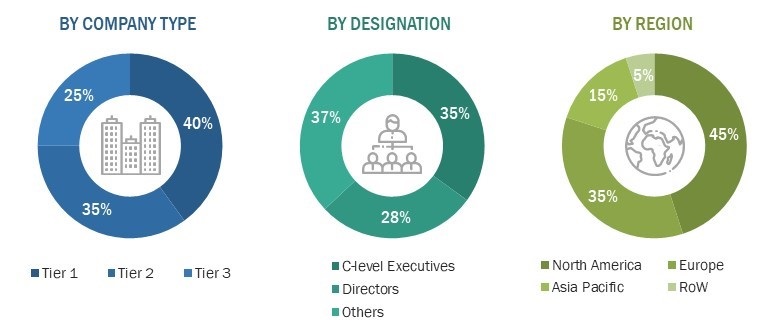
To know about the assumptions considered for the study, download the pdf brochure
Market Size Estimation
Both top-down and bottom-up approaches were utilized to estimate and validate the size of the automated passenger counting and information system market and its submarkets. Secondary research was conducted to identify the key players in the market, and primary and secondary research was used to determine their market share in specific regions. The process involved studying top players’ annual and financial reports and conducting extensive interviews with industry leaders such as CEOs, VPs, directors, and marketing executives. Secondary sources were used to determine all percentage shares and breakdowns, which were then verified through primary sources. All parameters that could impact the markets covered in this research study were accounted for, analyzed in detail, verified through primary research, and consolidated to obtain the final quantitative and qualitative data.
Global Automated Passenger Counting and Information System Market Size: Botton Up Approach
- Identifying verticals that are either using or will use automated passenger counting systems.
- Tracking leading companies and system integrators operating across various verticals.
- Deriving the size of the automated passenger counting system market through the data sanity method; analyzing revenues of more than 25 key providers through their annual reports and press releases and summing them up to estimate the overall market size.
- Analyzing the use cases across different regions and companies
- Tracking the ongoing and upcoming installation contracts, acquisitions, expansions, and product launches by various companies and forecasting the market size based on these developments and other critical parameters.
- Conduct multiple discussions with key opinion leaders to understand automated passenger counting and information system components offered by companies to various applications and analyze the breakdown of the scope of work carried out by each major company providing automated passenger counting and information system components.
- Carrying out the market trend analysis to obtain the CAGR of the automated passenger counting system market by understanding the industry penetration rate and analyzing the demand and supply of automated passenger counting systems in different verticals.
- Assigning a percentage to the overall revenue or, in a few cases, to each company's segmental revenues to derive their revenues from the sale of automated passenger counting systems. This percentage for each company has been assigned based on their product portfolios
- Verifying and crosschecking the estimates at every level through discussions with key opinion leaders, including CEOs, directors, operations managers, and domain experts at MarketsandMarkets
- Studying various paid and unpaid information sources, such as annual reports, press releases, and white papers

Global Automated passenger counting and information system Market Size: Top-Down Approach
The top-down approach has been used to estimate and validate the total size of the automated passenger counting and information system market.
- Information related to the revenue of key manufacturers and providers of Automated passenger counting and information system components was studied and analyzed to estimate the global size of the Automated passenger counting and information system market.
- Multiple discussions were conducted with key opinion leaders to understand the demand for automated passenger counting and information system solutions and analyze the breakdown of the scope of work carried out by each major company.
- Revenue, geographic presence, key applications served, and diverse offerings of all identified players in the Automated passenger counting and information system market were studied to estimate and arrive at the percentage split of different market segments.
- All major players in the Automated passenger counting and information system market were identified through secondary research and verified through brief discussions with industry experts.
- Multiple discussions were conducted with key opinion leaders of all key companies developing Automated passenger counting and information system solutions to validate the market split based on technology, industry, and region.
- Geographic splits were estimated using secondary sources based on factors such as the number of players offering automated passenger counting and information system solutions in a specific country or region and the industries for which these players provide the solutions.

Data Triangulation
Once the overall size of the automated passenger counting and information system market was determined using the methods described above, it was divided into multiple segments and subsegments. Market engineering was performed for each segment and subsegment using market breakdown and data triangulation methods, as applicable, to obtain accurate statistics. To triangulate the data, various factors and trends from the demand and supply sides were studied. The market was validated using both top-down and bottom-up approaches.
Market Definition
Automated passenger counting (APC) systems comprise electronic devices that count the number of passengers boarding and alighting transit vehicles, including buses, trains, and ferries. These systems offer more accurate and reliable results than the traditional method of counting passengers manually. With the help of the automatic passenger counter, every single passenger that goes on board and alights a public transit vehicle at each stop of any route can be monitored and recorded easily, which helps to simplify data collection and enables far greater accuracy and scope for generating database reports on ridership information.
Passenger information systems (PIS) are electronic information systems that provide passengers with real-time information. This information can be about the arrival and departure time of transit vehicles and the nature and cause of disruptions in case of any delays. These systems are installed at transportation hubs or can be used remotely through web browsers and smartphones.
The APC and PIS ecosystem comprises manufacturers of APC and PIS products and solutions. The market is diversified, consisting of companies from different regions of the world competing across its value chain to sustain their positions and increase their market shares. The market will likely witness significant growth in the coming years due to the surging demand for advanced automation solutions in the transportation sector.
Key Stakeholders
- Manufacturers and distributors of components used in automated passenger counting and information systems
- Providers of software used in automated passenger counting and information systems
- Providers of products and solutions used in automated passenger counting and information systems
- Distributors of automated passenger counting and information systems
- End users (fleet operators of buses, trains, and ferries, as well as transport service providers)
- System integrators
- Mobile application developers
- Networking and communication service providers
- Passenger information system software providers
- Governments, financial institutions, and investment communities
- Research organizations
Report Objectives
- To define, describe, and forecast the automated passenger counting and information system market based on offering & application, and region
- To forecast the size of the market segments for four major regions—North America, Europe, Asia Pacific (APAC), and the Rest of the World (RoW)
- To provide detailed information regarding the major factors influencing the growth of the market (drivers, restraints, opportunities, and challenges)
- To strategically analyze micromarkets1 with respect to individual growth trends, prospects, and contributions to the total market
- To study the complete value chain and allied industry segments and perform a market value chain analysis.
- To provide ecosystem analysis, case study analysis, patent analysis, technology analysis, pricing analysis, Porter’s five forces analysis, key stakeholders and buying criteria, key conferences and events, and regulatory bodies, government agencies, and regulations pertaining to the market
- To strategically profile the key players and comprehensively analyze their market shares and core competencies2.
- Analyzing the opportunities in the market for stakeholders and describing the market's competitive landscape.
- To analyze competitive developments such as collaborations, agreements, contracts, partnerships, mergers & acquisitions, product launches, and research & development (R&D) in the market
- To analyze the impact of the recession on the automated passenger counting and information system market
Available customizations:
With the given market data, MarketsandMarkets offers customizations according to the specific requirements of companies. The following customization options are available for the report:
- Detailed analysis and profiling of additional market players (up to 5)
- Additional country-level analysis of the automated passenger counting and information system market
Product Analysis
- Product matrix, which provides a detailed comparison of the product portfolio of each company in the automated passenger counting and information system market.




 Generating Response ...
Generating Response ...







Growth opportunities and latent adjacency in Automated Passenger Counting and Information System Market
We are most interested in the Automatic People Counting portion of the report, specifically for bus and rail transit in USA and EMEA. Moreover, we want to know more about respective market's leaders / shares, average pricing, unit volumes, trends, etc.
I am working with Urban Mass Transit Company (we are the leading consulting company in India dealing in urban mobility). Our project envisages to have 41 jetties and 82 boats and is the first of its kind in India and 2nd in terms of boats used for the mass transit in the world. As part of the project, we are proposing to include ITM system. An intelligent transportation system aims to provide innovative services relating to different modes of transport and traffic management and enable various users to be better informed and make safer, more coordinated, and 'smarter' use of transport networks. Knowing your strengths in ITMS , we would be very happy if you can let us know if you would be interested in being the part of this project and help us understand how your solutions can benefit our purpose. I am here by attaching basic requirements for the proposed system for your reference. Hope this clarifies and do let me know if you need any further clarifications.
Is this report includes Passenger Survey - Primary & Secondary, Preparation of Civil Aviation Development Plan, Preparation of Aerodrome License, Airport Security Program, SMS Manual things?